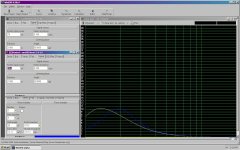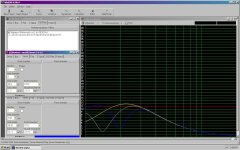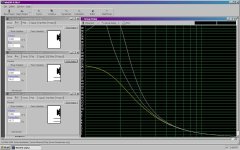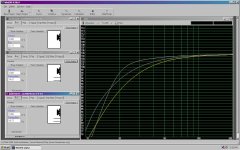Hi guys.
I have just purchased two SB acoustics 10" (SB29NRX75-6)drivers on ebay for a very good price.
I intend to use these in medium-large boxes for my sealed stand-mounters to stand on; a three way active system using MiniDSP 2x8's for cross-overs. Think of the Tarkus and the Troels Gravesen Jensen 1071 as my inspiration.
I will use these for 90% music, and play my TV/Movies throught them too. Therefore I want to get the best possible sound for music.
My DSP can perform any parametric equalising, and linkwitz transform that I like. My question is: Will the vented alignment or the Linkwitz Transform sound better for music?
I notice that in WinISD these drivers model best for sealed and vented in more or less the same sized enclosure for each. I quite like the idea of having a removable port that I can seal up to try either.
Do you have any suggestions or input?
Kind regards,
Jai Stanley
I have just purchased two SB acoustics 10" (SB29NRX75-6)drivers on ebay for a very good price.
I intend to use these in medium-large boxes for my sealed stand-mounters to stand on; a three way active system using MiniDSP 2x8's for cross-overs. Think of the Tarkus and the Troels Gravesen Jensen 1071 as my inspiration.
I will use these for 90% music, and play my TV/Movies throught them too. Therefore I want to get the best possible sound for music.
My DSP can perform any parametric equalising, and linkwitz transform that I like. My question is: Will the vented alignment or the Linkwitz Transform sound better for music?
I notice that in WinISD these drivers model best for sealed and vented in more or less the same sized enclosure for each. I quite like the idea of having a removable port that I can seal up to try either.
Do you have any suggestions or input?
Kind regards,
Jai Stanley
I like to design boxes so that they have a Qtc =.55 sealed and dual port them. one port open = ~14Hz, two ports open =18Hz~ a hybrid is easy enough to design and you get the best of both worlds.
which would sound better for music... depends on the music, and the person, and the room, and the wife, etc. etc. etc.
which would sound better for music... depends on the music, and the person, and the room, and the wife, etc. etc. etc.
jainstanley, your question can be translated into: no time smearing with the risk of increased harmonic distortion, or time smearing with less harmonic distortion? The right answer varies with circumstance: how big a room you have to cover, what max levels you require, etc.
well.. i just designed the WIWD, 3ft^3 box two 3" (7.6cm) ports, 30" (76cm) long. 75w per, high-pass at 18Hz, no LT the driver doesn't have enough Xmax 
Attachments
Last edited:
Hi,
Vented has more low end max SPL, I've never seen a driver where good
sealed and vented alignments require the same box volume. Bottom line
is vented ups max SPL at port frequency by +6db, but requires a sub
filter below that to prevent overexcursion overload.
IF sealed LT is loud enough, its by far the best option SQ wise.
rgds, sreten.
Vented has more low end max SPL, I've never seen a driver where good
sealed and vented alignments require the same box volume. Bottom line
is vented ups max SPL at port frequency by +6db, but requires a sub
filter below that to prevent overexcursion overload.
IF sealed LT is loud enough, its by far the best option SQ wise.
rgds, sreten.
No one expects the bass quality and depth from the tiny Linkwitz Pluto when they first hear it. All down to sealed enclosure loading and Linkwitz transform. With a decent long throw motor system the quality can he highly impressive.
I would go with Sreten's suggestion unless it is for non stop bangin' techno or metal at really high volumes in which case you could be safer with a standard ported system.
I would go with Sreten's suggestion unless it is for non stop bangin' techno or metal at really high volumes in which case you could be safer with a standard ported system.
Hi, The Pluto does not use an LT, its subwoofer does, rgds, sreten.
Hi Sreten,
I use the later Pluto 2.1 with LT.
Also from the Pluto 2 article, a page detailing the upgrade from Pluto 1 with Peeless driver to the newer Seas unit and detailing the LT circuit change.
Pluto-2 omni-directional loudspeaker
From that page:
"Pluto-2 is a small 2-way loudspeaker system that brings a number of practical refinements to the original PLUTO design and construction. A key component is the Seas L16RN-SL (H1480-08) midrange/woofer driver. It allowed to extend the loudspeaker's frequency response down to 40 Hz, -3 dB because of its greater excursion capability before unacceptable distortion. Pluto-2 is thus to me a full-range speaker for a wide range of program material. It should be optimal for people with small spaces or low budgets and who want accurate sound reproduction."
Transient response is defined by onset and decay.I think also the question should be: which has the better transient response? I have no idea myself.
Group delay defines how late the onset of sound emission is. Here vented has lots more, roughly double.
There is also the box/vent resonance decay, ie how long it takes for this component of sound emission to cease. This takes a while because air is both elastic and not too lossy. Therefore vented boxes take variable amounts of time to round up their sound emission, sometimes very long ones, depending on particulars. Closed box, LT'd or not, has none of this because there is no vent air mass to resonate.
So vented can not match closed box for time performance. At best it can hope to approach it. At worst, vented can moan, drone, huff and puff like a leaky bagpipe that's got the sniffles.
It all boils down to the nature of resonating systems. A resonance takes time to build up and time to die down. A closed box has one such resonant system. A vented box has two, and staggered ones at that, with the second one consisting entirely of air (air mass, air compliance, air friction).
well, a ported box has the same delay as a sealed box at double the tuning frequency (and up). So tune to 27hz and a 63hz tone would be just as fast (ms delay) as if the same sized box was sealed.
but..........
I just found this on linkwitz site.
"Not only is the frequency response extended, but the time response is also improved, as indicated by the reduced overshoot and ringing of the lower cut-off highpass filter step response." below middle of the page on linkwitz transform circuit.
Active Filters
To me, your room will be storing then releasing the bass pressure (under 60hz) much slower than your subwoofer.
I sold a 6th order pair of 12" (6db boost/cut filter) ppsl to a buddy who was disgusted that this ported beat his 3 x 10" sealed qtc .707 jl audios. ppsl was deeper, punchier, cleaner, and quicker. Yes a ported seemed faster than a sealed, but the canceling of harmonic distortion and less excursion made for a much cleaner sound.
I do also know I like 30hz tuning better than 40hz listening to music then stuffing 1 of my ports.
Norman
but..........
I just found this on linkwitz site.
"Not only is the frequency response extended, but the time response is also improved, as indicated by the reduced overshoot and ringing of the lower cut-off highpass filter step response." below middle of the page on linkwitz transform circuit.
Active Filters
To me, your room will be storing then releasing the bass pressure (under 60hz) much slower than your subwoofer.
I sold a 6th order pair of 12" (6db boost/cut filter) ppsl to a buddy who was disgusted that this ported beat his 3 x 10" sealed qtc .707 jl audios. ppsl was deeper, punchier, cleaner, and quicker. Yes a ported seemed faster than a sealed, but the canceling of harmonic distortion and less excursion made for a much cleaner sound.
I do also know I like 30hz tuning better than 40hz listening to music then stuffing 1 of my ports.
Norman
Transient response is defined by onset and decay.
Group delay defines how late the onset of sound emission is. Here vented has lots more, roughly double.
There is also the box/vent resonance decay, ie how long it takes for this component of sound emission to cease. This takes a while because air is both elastic and not too lossy. Therefore vented boxes take variable amounts of time to round up their sound emission, sometimes very long ones, depending on particulars. Closed box, LT'd or not, has none of this because there is no vent air mass to resonate.
So vented can not match closed box for time performance. At best it can hope to approach it. At worst, vented can moan, drone, huff and puff like a leaky bagpipe that's got the sniffles.
It all boils down to the nature of resonating systems. A resonance takes time to build up and time to die down. A closed box has one such resonant system. A vented box has two, and staggered ones at that, with the second one consisting entirely of air (air mass, air compliance, air friction).
"At worst, vented can moan, drone, huff and puff like a leaky bagpipe that's got the sniffles."
In fairness results this bad are somewhat rare these days. But I have heard some really bad examples in the past.
"So vented can not match closed box for time performance. At best it can hope to approach it."
Agreed, if you want a sub that can make you really jump then a closed box is the best for immediacy. That said I have heard clunky old closed box sub's bettered by newer vented systems, the best sensible sized sub's still all seem to be closed box though.
"A closed box has one such resonant system. A vented box has two, and staggered ones at that"
leaky Aperiodic systems were designs to remove or reduce the one box
hump (and allow designers to build smaller boxes) I haven't seen any Aperiodic home sub's though. I do not know if there would be any real benefits with modern EQ.
Subjectively I have always preferred closed box bass. This was a big part of the appeal of Pluto 2.1 for me.
What about Mr. Cordell's EQSS? Low tuned vented enclosure with the LT applied. Replace the big port with a passive radiator if you need to. Reduced cone excursion like a vented but group delay more similar to a closed box. (I've not tried this yet myself, just something interesting.)
http://www.cordellaudio.com/loudspeakers/EQSS_White_Paper.pdf
http://www.cordellaudio.com/loudspeakers/EQSS_White_Paper.pdf
Thanks muchbbggg (and rob g), you've succinctly written the epitaph for "reflex" boxes.
Just occurred to me that the BR design might be thought of in historical terms as a stop-gap approach to produce some sense of extra-low bass from drivers with 35-45 Hz resonances of yesteryear. Not much reason to live with BR shortcomings (as presented previously), when you can make drivers with lower resonances and just put them in a sealed box with no high-falutin' design effort needed*.
Ben
*as far as I know, within reason almost any sealed box will give you some kind of OK bass, arithmetically optimum or not. Or slightly leaky box maybe even better too.
Just occurred to me that the BR design might be thought of in historical terms as a stop-gap approach to produce some sense of extra-low bass from drivers with 35-45 Hz resonances of yesteryear. Not much reason to live with BR shortcomings (as presented previously), when you can make drivers with lower resonances and just put them in a sealed box with no high-falutin' design effort needed*.
Ben
*as far as I know, within reason almost any sealed box will give you some kind of OK bass, arithmetically optimum or not. Or slightly leaky box maybe even better too.
Last edited:
Thanks for the cordell link William! very interesting. It also shows clearly one of the tradeoffs of using the linkwitz transform.. The amount of extra power required to drive the speaker (which also then implies that the drivers must be capable of handling significantly higher power).
I've been wondering myself about sealed vs vented for when I redeploy the 10" drivers in my three ways (currently vented) as dedicated subs. I will be investigating the EQSS now
Tony.
I've been wondering myself about sealed vs vented for when I redeploy the 10" drivers in my three ways (currently vented) as dedicated subs. I will be investigating the EQSS now
Tony.
No, there is a positive side and that isThanks muchbbggg (and rob g), you've succinctly written the epitaph for "reflex" boxes
because of reduced excursion demands for the same SPL. To match this, a larger driver in a sealed alignment would be needed. Depending on circumstances, a vented system may be the optimal compromise.less harmonic distortion
Conventionally produced, multimiked pop music has no phase coherence at all, because of the way it is recorded, mixed, equalized and mastered. There are a multitude of superimposed low pass filters in these procedures which render trrelevant all notions of LF time coherence in the final product. In such cases listening to vented systems will not impair things further because there's nothing left to impair.

That's replacing air mass and air friction with passive radiator mass and suspension friction. Unlike air, those can be manipulated. Unlike air, they can also introduce distortion. Well, air can introduce distortion too sometimes -but it's fairly easy to avoid. Sometimes.Replace the big port with a passive radiator if you need to
No, there is a positive side and that is because of reduced excursion demands for the same SPL [due to less distortion]. To match this, a larger driver in a sealed alignment would be needed. Depending on circumstances, a vented system may be the optimal compromise.
snip
True, there is less movement of the cone (and hence less distortion) in vented enclosures north of the system resonance when the vent augments the sound by feeding out system upper-resonance into the room. But I believe at box resonance and below, the situation is different.
But hard to say if distortion is harder to take in the Hz region above resonance compared to sound below resonance.
Ben
Thanks to William2001,
interesting concept, I expect you would find many retail/commercial systems use a combination of low frequency equalization and porting just like this.
I find passive radiator systems sound different again to ported and closed box. PR's systems tend to be the systems that sound subjectively the slowest but great for powerful rumble in Home Cinema. I think there are excellent examples with all these systems. Annoyingly the room makes the biggest difference, by a country mile.
Mr Linkwitz makes no secret about the requirement of extra power and the need for drivers with more expensive, better quality long throw motor systems.
It is pretty obvious that there is no such thing as a free lunch.
Also I am wary of general recommendation of powerful low frequency equalization for really modest size systems going into larger spaces (driven by WAF!). Pluto pushes a small drive unit really hard to produce deep bass, I would be wary of damage from users trying to produce the deepest bass in a large room at moderately high volume.
Mr Linkwitz did not have dub bass and Massive attack on his mind when he designed Pluto, even the add on subwoofer option for that matter!
I say I have a subjective preference for sealed loading because you can look at the figures one way or another and even present the resonant reflex systems as superior, in terms of distortion, or in terms of transient response.
Choosing ported reflex systems certainly gives you more choice in terms of drive units. Also the majority of systems are ported because it is now cheap and easy to make passive speaker systems with modest cost drivers (with cheaper light weight motor systems) for obvious punchy bass, compatible with more modest power amplifiers. Since the majority of speakers are now reflex designs the majority of good designs out there are also reflex designs!
In very large speakers you can have a low distortion system that acts more like a sealed system but with a very low tuned port to extend deep bass and reduce distortion. ATC tune their speakers like this. The majority of their smaller speakers are closed box but the larger systems are ported.
Whether I am listening to Classical, Acoustic, Rock, jazz, Electronic, or whatever I tend to prefer well designed closed box speakers. Certainly the difference is greatest or most noticeable on well recorded Classical material as bbggg implies.
Linkwitz transform is a good system for getting deeper bass out of modest size systems and maintaining high quality at the same time. I have never heard an equivalent sized passive speaker produced such tight, well balanced bass with proper extension.
Usually in modest size passive systems you have to choose between too dry but well tuned bass or overt thumpy punchy bass speaker effects.
This to me is a major benefit of active speakers, at least for people who live in the real world, not the tiny minority who can fill their homes with enormous speakers and multiple sub's.
interesting concept, I expect you would find many retail/commercial systems use a combination of low frequency equalization and porting just like this.
I find passive radiator systems sound different again to ported and closed box. PR's systems tend to be the systems that sound subjectively the slowest but great for powerful rumble in Home Cinema. I think there are excellent examples with all these systems. Annoyingly the room makes the biggest difference, by a country mile.
Mr Linkwitz makes no secret about the requirement of extra power and the need for drivers with more expensive, better quality long throw motor systems.
It is pretty obvious that there is no such thing as a free lunch.
Also I am wary of general recommendation of powerful low frequency equalization for really modest size systems going into larger spaces (driven by WAF!). Pluto pushes a small drive unit really hard to produce deep bass, I would be wary of damage from users trying to produce the deepest bass in a large room at moderately high volume.
Mr Linkwitz did not have dub bass and Massive attack on his mind when he designed Pluto, even the add on subwoofer option for that matter!
I say I have a subjective preference for sealed loading because you can look at the figures one way or another and even present the resonant reflex systems as superior, in terms of distortion, or in terms of transient response.
Choosing ported reflex systems certainly gives you more choice in terms of drive units. Also the majority of systems are ported because it is now cheap and easy to make passive speaker systems with modest cost drivers (with cheaper light weight motor systems) for obvious punchy bass, compatible with more modest power amplifiers. Since the majority of speakers are now reflex designs the majority of good designs out there are also reflex designs!
In very large speakers you can have a low distortion system that acts more like a sealed system but with a very low tuned port to extend deep bass and reduce distortion. ATC tune their speakers like this. The majority of their smaller speakers are closed box but the larger systems are ported.
Whether I am listening to Classical, Acoustic, Rock, jazz, Electronic, or whatever I tend to prefer well designed closed box speakers. Certainly the difference is greatest or most noticeable on well recorded Classical material as bbggg implies.
Linkwitz transform is a good system for getting deeper bass out of modest size systems and maintaining high quality at the same time. I have never heard an equivalent sized passive speaker produced such tight, well balanced bass with proper extension.
Usually in modest size passive systems you have to choose between too dry but well tuned bass or overt thumpy punchy bass speaker effects.
This to me is a major benefit of active speakers, at least for people who live in the real world, not the tiny minority who can fill their homes with enormous speakers and multiple sub's.
- Status
- This old topic is closed. If you want to reopen this topic, contact a moderator using the "Report Post" button.
- Home
- Loudspeakers
- Subwoofers
- Better for music: Sealed with Linkwitz Transform or Vented?



